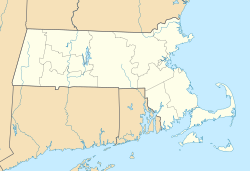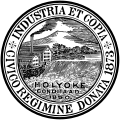Description and history
The Central Churchill Historic District is located roughly at the center of Holyoke's Churchill neighborhood, south of its main downtown area. This area was platted but not developed when the city was laid out in 1848. In 1870, the first major development in the area was the Church of the Sacred Heart, a Gothic Revival structure that was soon accompanied by a Second Empire rectory (1878). The construction of the German Reformed Church in 1890, also in the Gothic Revival style, led the area to become known as "Church Hill", later shortened to "Churchill". The blocks surrounding the churches and adjacent to Chestnut Street Park were heavily developed in the following decades with apartment blocks in a variety of styles. [2]
The Sacred Heart complex occupies a city block bounded by Chestnut, Sargeant, Maple, and Franklin Streets, and forms the center of the district. It extends north to include buildings facing Chestnut Street Park on Chestnut and Sargeant Streets, as well as the German Reformed Church just northwest of the park. It extends east to include the west side of High Street to the east. The majority of buildings in the district are brick and stone multiunit apartment houses. [2]
This page is based on this
Wikipedia article Text is available under the
CC BY-SA 4.0 license; additional terms may apply.
Images, videos and audio are available under their respective licenses.



